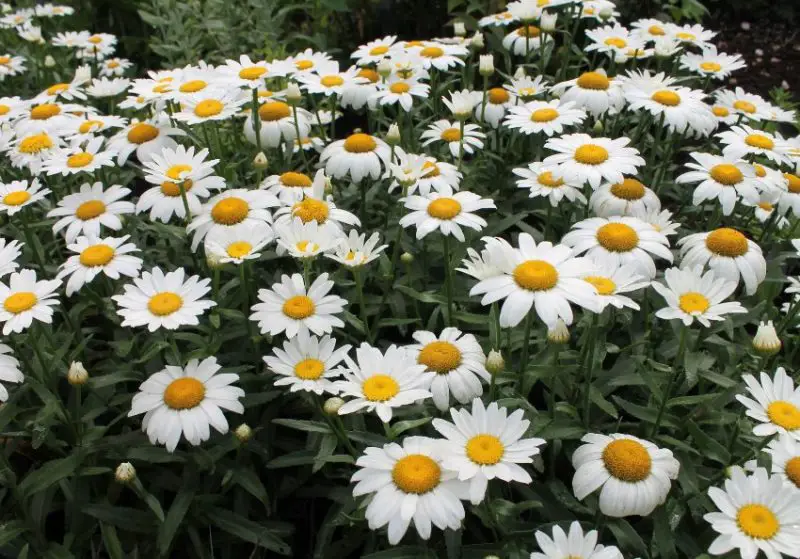The Shasta Daisy (Leucantheum x superbum) is a beloved perennial that has captured gardeners’ hearts since the early 20th century. Known for its long-lasting blooms, this plant features cheerful white flowers with bright yellow centers. Blooming during the spring and summer, Shasta daisies bring purity, simplicity, and innocence to your garden. These daisies can grow between 9 inches and 3 feet tall, with sturdy green foliage that often remains evergreen in warmer climates.
In this ultimate care and growing guide, we’ll explore the ideal conditions for growing Shasta daisies, how to propagate them, the varieties available, and tips for keeping them healthy.
Understanding Shasta Daisy Characteristics

Shasta daisies are not just visually appealing but are also relatively easy to grow and maintain. Here are some key characteristics:
- Common Name: Shasta Daisy
- Botanical Name: Leucanthemum × superbum
- Family: Asteraceae
- Plant Type: Perennial
- Mature Size: 9 in. to 3 ft. tall, 1-2 ft. wide
- Sun Exposure: Full sun, partial sun
- Soil Type: Moist, well-drained
- Soil pH: Neutral
- Bloom Time: Spring, Summer
- Flower Color: White petals, yellow center
- Hardiness Zones: USDA zones 5-9
- Native Area: North America
- Toxicity: Toxic to pets (dogs and cats)
Planting Shasta Daisies
Shasta daisies thrive best when planted in early spring or summer. In colder climates, avoid planting in fall to prevent cold temperatures from damaging the young plants. These flowers prefer full sun but can tolerate some partial shade. They need about 1 to 2 feet of space between them for proper air circulation and growth.
Steps for Planting Shasta Daisies:
- Dig a hole slightly deeper than the root ball.
- Space plants 1-2 feet apart.
- Place the plant in the hole, ensuring that the crown is level with the soil.
- Backfill with soil and water thoroughly.
Once established, Shasta daisies are vigorous growers and may spread quickly via rhizomes, making them great for filling garden spaces with bright blooms. However, regular maintenance is necessary to prevent overcrowding.
Light Conditions for Optimal Growth
The Shasta daisy prefers full sunlight but can also tolerate partial shade. For the healthiest plants and most vibrant blooms, try to provide at least 6 hours of direct sunlight daily. Plants grown in full sun will produce more flowers, but they can adapt to slightly shadier areas where the blooms might appear earlier but be slightly less abundant.
Ideal Soil for Shasta Daisies
Shasta daisies perform best in rich, fertile soil that is well-drained. Adding organic matter like compost to the soil can help improve both nutrient availability and drainage, which are critical for healthy growth. While these plants are relatively tolerant of poor soil, they should not be left in soggy or waterlogged soil, as this can lead to root rot.
Key Tips for Soil:
- Ensure soil is well-draining to avoid water accumulation.
- Add compost or other organic material for a nutrient boost.
- Maintain a neutral soil pH for the best growth conditions.
Watering Shasta Daisies
Shasta daisies enjoy moist, well-drained soil but do not tolerate soggy conditions. Overwatering can lead to diseases like root rot. During dry or hot periods, be sure to water the daisies regularly to maintain their health. A good rule of thumb is to provide about 1 inch of water per week, either through rainfall or manual watering. In areas with good rainfall, watering may be less necessary.
Temperature and Humidity Tolerance
Shasta daisies are hardy plants that thrive in a wide range of temperatures and humidity levels, making them suitable for USDA zones 5 to 9. However, in areas with high humidity, make sure to manage moisture levels carefully to prevent the soil from becoming waterlogged, which can lead to fungal infections.
In cold climates, the foliage may die back during the winter, but the plant itself is perennial and will return each spring. In warmer zones, the plant’s foliage may remain evergreen throughout the year.
Fertilizing for Healthy Growth
Although Shasta daisies do well in nutrient-rich soils, they benefit from annual fertilization. A layer of compost added in the spring provides a natural nutrient boost before the blooming season. Alternatively, you can use a balanced fertilizer monthly during the growing season. Fertilizing will help support their long-lasting blooms and ensure that the plant remains healthy year after year.
Varieties of Shasta Daisies
There are many cultivars of Shasta daisies to choose from, each offering slightly different characteristics. Here are some popular varieties:
- ‘Becky’: One of the tallest varieties, reaching 3-4 feet in height, with sturdy stems that resist staking.
- ‘Snow Lady’: A dwarf variety, growing only 9-12 inches tall, perfect for smaller gardens or containers.
- ‘Crazy Daisy’: Features double blooms with ruffled, twisty petals and grows up to 2 ½ feet tall.
Pruning for Better Blooms
To encourage more blooms throughout the growing season, deadhead spent flowers regularly. This process helps the plant focus energy on producing new blooms rather than seed formation. At the end of the season, when the plant begins to fade, you can cut the foliage back to ground level to prepare for overwintering.
Propagating Shasta Daisies
One of the best ways to extend the life of your Shasta daisies and create new plants is by division. Shasta daisies should be divided every 2 to 3 years to prevent overcrowding and keep the plants healthy.
How to Propagate by Division:
- Use a shovel to loosen the soil around the plant.
- Lift the plant and divide it using a sharp spade.
- Ensure each division has healthy roots and foliage.
- Replant divisions immediately in prepared soil, spacing them properly.
Growing Shasta Daisies from Seed
Growing Shasta daisies from seed is a rewarding project, though it can result in plants that revert to parent types like the oxeye daisy. Seeds can be started either indoors or outdoors, depending on the time of year.
Outdoor Seed Planting Tips:
- Sow seeds in spring or early fall in fertile soil.
- Scatter seeds lightly, without burying them, as they need light to germinate.
- Water consistently until seedlings are established.
Indoor Seed Starting:
- Start seeds 6 to 10 weeks before the last frost.
- Press seeds into the soil surface and keep moist.
- Once seedlings are strong, harden them off before planting outside.
Common Problems with Shasta Daisies
Although Shasta daisies are hardy, they can face issues like wilt and root rot, especially in soggy conditions. To avoid these problems:
- Ensure plants are in well-drained soil.
- Avoid overwatering.
- Remove infected foliage immediately to prevent the spread of disease.
Final Tips for Success
With proper care, Shasta daisies can provide vibrant, long-lasting blooms for many years. By ensuring they receive adequate sunlight, well-drained soil, and the occasional dose of fertilizer, these cheerful flowers will thrive and brighten up your garden. Whether grown in the ground or containers, Shasta daisies are a resilient and beautiful addition to any landscape.






